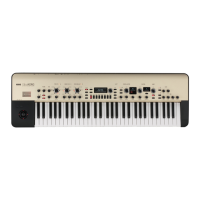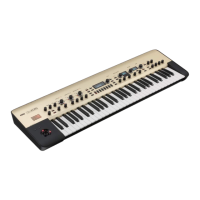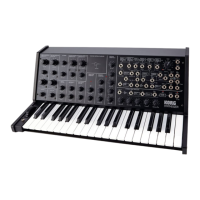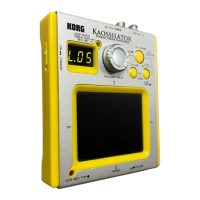-
11 -
KingKORG Parameter Guide Parameters
s43
~
47: EG1-Filter
Here you can adjust settings for the filter EG that causes the sound to vary
over time.
Here you can adjust settings for the filter EG, which creates time-varying
changes in the tonal character. Specify the EG settings in these pages, and
use the EG1Int parameter (→ p.10) to specify how deeply the filter will be
affected by the EG. Use the ADSR (Attack, Decay, Sustain, Release)
parameters to create the desired curve of tonal change.
TIP:
By assigning EG1-Filter as the source for a virtual patch, you can use it to modulate
parameters other than the lter (→ p.12).
EG (Envelope Generator)
To a significant extent, each sound has its own distinctive volume curve. For
example when you play a note on a piano, the note begins at the maximum
volume, and gradually diminishes. When you release your finger from the key,
the sound will disappear quickly with a brief decay. Volume curves such as this
are an important aspect of how we identify the sound of a specific instrument.
This type of change also occurs in the tone and pitch, as well as in the volume.
On a synthesizer, this type of change is produced by an EG. The KingKORG
has dedicated EGs for the filter and for the amp. However since these EGs
can be used as Virtual Patch sources, you are also free to use them to vary
the pitch or numerous other aspects of the sound. Some example amp EG
settings are illustrated below.
0
Attack Level
Time
Note on
Note off
Level
[1]: Attack Time [3]: Sustain Level
[2]: Decay Time [4]: Release Time
[1]
[3]
[4]
[2]
EG
0
Time
Note on
Note off
Level
Attack: 0 Sustain: 0
Decay: 100 – 127 Release: 5 – 25
Piano
0
Time
Note on
Note off
Level
Attack: 0 Sustain: 127
Decay: 0 Release: 0
0
Time
Note on
Note off
Level
Attack: 40 Sustain: 75
Decay: 50 Release: 50
Strings
Attack (Attack Time/EG1-Filter) .................................[000…127]
This specifies the time from note-on (when the key is pressed) until the attack
level (maximum value of the envelope) is reached.
Decay (Decay Time/EG1-Filter) ..................................[000…127]
This specifies the time from when the attack level is reached until the sustain
level (SUSTAIN) is reached.
Sustain (Sustain Level/EG1-Filter) .............................[000…127]
This specifies the cutoff frequency that will be maintained after the decay time
has elapsed, until you release the key.
Release (Release Time/EG1-Filter) .............................[000…127]
This specifies the time from note-off (when the key is released) until the level
reaches 0.
LevelVelInt (Level Velocity Intensity/EG1-Filter) .....[–63…+63]
This specifies how your keyboard velocity (playing strength) will affect the
amplitude of EG1-Filter. Higher settings of this parameter will allow changes in
your keyboard velocity to produce greater differences in EG1-Filter amplitude.
s48
~
52: EG2-Amp
Here you can adjust the settings for the AMP EG, which applies time variant
changes to the volume. Using the AMP EG settings, you can make the volume
change as time passes. Create the desired volume curve by adjusting the
ADSR parameters; ATTACK, DECAY, SUSTAIN, RELEASE.
TIP:
You can use EG2 as a Virtual Patch source to modulate parameters other than volume
(→ p.12).
EG1 and EG2
As the EG1-Filter changes the cutoff frequency, the tone will change. However,
the overall character of the sound will also depend on the volume changes that
are produced by the EG2-Amp. For example, setting a long decay for the Filter
EG (EG1) will produce a different sound depending on how the decay is set in
the Amp EG (EG2). It’s a good idea to be aware of both the EG1-Filter settings
and the EG2-Amp settings as you’re editing.
Attack (Attack Time/EG2-Amp) .................................. [000…127]
This specifies the time from note-on (when the key is pressed) until the attack
level (maximum value of the envelope) is reached.
Decay (Decay Time/EG2-Amp) ...................................[000…127]
This specifies the time from when the attack level is reached until the sustain
level (SUSTAIN) is reached.
Sustain (Sustain Level/EG2-Amp) ..............................[000…127]
This specifies the volume that will be maintained after the decay time has
elapsed, as long as you continue holding the key.
Release (Release Time/EG2-Amp) .............................. [000…127]
This specifies the time from note-off (when the key is released) until the level
reaches 0.
LevelVelInt (Level Velocity Intensity/EG2-Amp)
...[–63…+63]
This specifies how your keyboard velocity (playing strength) will affect the
EG2-Amp. Higher settings of this parameter will allow changes in your
keyboard velocity to produce greater differences in EG amplitude.
s53
~
62: LFO1, LFO2
Each timbre contains two LFOs. An LFO produces a cyclic change that can be
used to modulate the pitch, tone, or volume of the sound.
TIP:
By assigning LFO1 or LFO2 as sources for a virtual patch, you can use them to modulate a
variety of parameters (→ p.12).
LFO (Low Frequency Oscillator)
The LFO (Low Frequency Oscillator) is an oscillator with a low (slow) rate.
It is typically used to apply a vibrato effect (use LFO to raise and lower the
pitch), wah effect (use LFO to raise and lower the cutoff frequency), or tremolo
effect (use LFO to raise and lower the volume).
You can select LFO as a Virtual Patch source, select the desired parameter as
the destination, and apply modulation to produce various effects. The
KingKORG provides special parameters that can be modulated from an LFO.
For LFO1, these parameters are the “Filter” page parameters LFO1ModInt and

